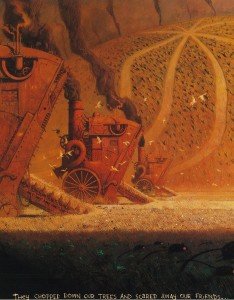The Rabbits is either a story of bunnies gone bad, or an allegory about imperialism leading to cultural and environmental decimation. As the Easter season approaches, I hesitate to say anything that might compromise the delivery of a Mr Fruit n’ Nut on Sunday morning, therefore I’m going with the allegorical angle. It’s safer that way, and let’s face it, forests…cultures…they come, they go, but chocolate is forever.
Written by John Marsden and illustrated by Shaun Tan, an illustrator previously reviewed in Shoot Me Now, The Rabbits is yet another brilliant example of Tan’s untethered imagination. There are no basket-wielding bunnies in this story, no cotton-tails or floppy ears. In the surreal landscape of Shaun Tan’s wondrously strange brain, no image, especially no stereotypical image, is safe.
Both Marsden and Tan hail from Australia. The Aussie influence is present in the aborigine/first peoples-inspired opening line, “The Rabbits Came Many Grandparents Ago”, and it is most certainly present in the gorgeous desert colours of the first few illustrations, but otherwise it’s a culturally interchangeable story of colonialism and environmental desolation. Every continent has one, except perhaps Antarctica (although I hear the penguins, the most affable of flightless birds, used to have a thriving civilization until the thick-skulled, and thoroughly unpleasant leopard seal showed up, ruining everything.)
In this particular retelling of man’s inhumanity to man (and trees), the baddies are played by rabbits, which are in no way affiliated with the Easter Bunny© or His delicious associate, Mr Fruit n’ Nut. With their flat heads, high collars and banker attire, the rabbits are a decidedly unfriendly lot, in comparison to the armadillo-like creatures, who live in trees and are befuddled and outnumbered by the colonizing rabbits.
No attempt is made to assimilate with the locals, preferring instead to overlay an entirely new and exploitive way of life upon the land, with the usual catastrophic results. Imperialism has never looked so lovely.
Marsden’s simple and sombre message is overwhelmed by Tan’s dystopic visions. The illustrations are so dazzling, the fact that armadillos are being enslaved and the land destroyed is mere background noise to the painterly drama unfolding in front of us.
No disrespect to Marsden, but Tan’s illustrations are the story, they are always the story, soaring past the words on the page, mindful of the text but ultimately powered by their own visual sensibilities. This is true regardless of where the words originate, as more often than not, Tan writes his own stories. In The Rabbits, the illustrations have an acid gleam, due in part to Tan’s masterful skills in oil, but also in the way the edgy colour choices and aggressive compositions reflect and advance the unsentimental storyline. The mechanized world of The Rabbits includes giant Max Ernst-like farming equipment, painted in the same terra-cotta colour as the sunlit desert of the opening scene. Even as it belches dirty plumes of smoke into the air, it’s a beautiful thing.
The Alberta oil sands industry would do well to hire Shaun Tan as their PR officer.
In the final scene of the book, the rabbit and the armadillo stand facing one another over a small pool of water, surrounded by a defoliated and garbage-strewn landscape. The line reads, “Who will save us from the rabbits?” Well Mr Armadillo, I believe I have an answer to that question. As this is a sort of post-apocalyptic Australia, there is only one possibility: Mel Gibson, in full body leather, driving a souped up Ford Falcon. The real question is, who will save us from Mel?
The Rabbits (2003), written by John Marsden and illustrated by Shaun Tan is published by Simply Read Books of Vancouver, Canada. Along with Shaun Tan’s fabulous website, I recommend having a browse through the Simply Read website. They are a small but dedicated operation, focused on publishing and distributing scrumptious picture books, several of which have been or will be reviewed in this blog.




